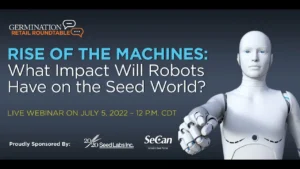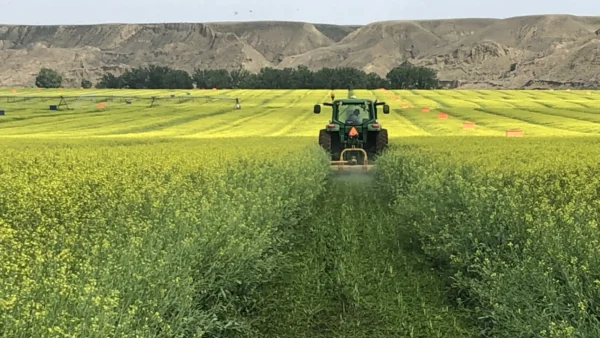To dispel the myths surrounding artificial intelligence in the ag world, it’s worth taking a deeper look at what AI can do.
Dramatic leaps in computing power have moved artificial intelligence (AI) from the realm of science fiction screenplays to everyday reality. Serious discussions of AI typically focus on uses such as self-driving cars, trading stocks, diagnosing illness or playing chess. Agricultural applications are usually nowhere to be found in popular discussions of the subject, even though AI is potentially a far more important use of this technological breakthrough. In fact, AI may very well save our industry.
Consider what agriculture might look like in a future where advanced AI systems are fully developed and deployed across the food-growing value chain. Hollywood has conditioned us to expect the worst. It’s not hard to imagine the silver screen’s alternative vision of agricultural AI, with self-aware combines and tractors going on a rampage, wiping out farms in their path.
While fiendish robots sell movie tickets, this is not a realistic vision of the future. Even so, benign AI systems raise their own disturbing questions by moving in on the one area in which humans have always enjoyed a monopoly — intelligence. If AI takes over in agriculture, what sort of job is left for the farmer?
To clarify the situation, it helps to define our terms.
AI is a form of machine learning that describes the ability of an algorithm to sense its environment, process the data and independently adapt to expected and unexpected scenarios. Rather than repeat a pre-programmed sequence of responses to situations, true AI systems absorb large amounts of data, discover the relevant patterns contained therein and come up with potential solutions. Through its raw computing power, such algorithms weigh the statistical likelihood of various outcomes from each potential solution so that the best option may be selected and acted upon.
The value of an AI’s choice depends on the quality of the data it receives. More data, particularly a greater amount of accurate data, enhance AI’s ability to correctly evaluate the range of possible outcomes. The most cutting-edge AI research focuses on mimicking the brain’s neural pathways in a way that augments, rather than replaces, human capabilities. The term AI is used when describing algorithms as “smart,” referring to the system’s adaptability. Instead of scripting an analysis, the AI is able to understand an unexpected situation in a more human way.
When an AI system comes up with a solution to a problem, it does so without emotion, without ego, without superstition and without any of the typical faults that impede human judgment.
At heart, the AI is a tool, and from its earliest days 10,000 years ago, agriculture has been at the forefront of adopting new tools. Sickles made of baked clay and primitive wooden ploughs made Neolithic harvests possible. In the course of thousands of years, these tools gave way to iron implements and sharp blades. Steam power replaced oxen and horse to be replaced later by gasoline and diesel engines. It’s only a matter of time before all-electric and hybrid motors supplant internal combustion on the farm.
Machines began replacing humans in agriculture quite some time ago. Self-driving combines and tractors are a reality, using GPS sensors to precisely do what were once back-breaking jobs. Nostalgia aside, few would seek to return to the old way.
Dispelling the Myths of Agricultural AI
To dispel the myths surrounding AI, it’s worth taking a deeper look at what AI can do. Far from being the precursor of humanity’s doom, AI may very well play a decisive role in solving one of the biggest challenges humanity faces: the global food security crisis.
An agricultural industry that incorporates advanced AI into all of its processes would deliver benefits on a global scale. It would mean better-informed decisions made more quickly and accurately despite rapid changes in the environment. It would mean more stable commodity markets as traders act on knowledge instead of speculation. It means a mitigation of the environmental impacts of farming as inputs are precisely delivered. Most importantly, it would mean driving the innovation that’s needed to deliver food on the scale needed to feed 9.8 billion by the year 2050.
Those are some impressive benefits, but to take advantage of them, our industry must think differently about the role of AI in the fields.
AI Remains a Thought Experiment in Agriculture
The information revolution has begun to transform agriculture, but are we on the verge of something bigger, the artificial intelligence (AI) revolution? All the elements needed to bring AI to agriculture exist, but they must be put together correctly.
Data collection systems track information as crops make their way from bags of seed to the fields, and ultimately to the supermarket. Each link in the value chain can be closely examined throughout the process. The sheer number of measurements, test results and real-time parameters gathered by the minute far exceed any person’s ability to comprehend it all.
That’s where data analytics plays a role, absorbing all of this information and making sense of it with an output better matched to human understanding. This might take the form of a digital map that uses red highlights to mark problem areas. Or, the output could be a graph tracking market trends over time.
AI takes information processing to the next level. Wouldn’t it be valuable to assess real-time data from the fields and compare and contrast various scenarios to better understand what’s happening in the global marketplace? Such capabilities take advantage of machine learning to interpret rapidly changing circumstances.
Currently, a commodity trader interested in what’s going on in the United States has to wait for the agriculture department to release the latest crop figures and related regional information. While these reports are reliable, the data comes from surveys that, in some cases, are filled out on paper and mailed in.
Instead of looking at what happened in the past, the AI alternative would give commodity traders a firmer foundation upon which to look ahead. For instance, he might see at a glance that a massive storm threatens to bring severe losses to the corn and soybean crops in Iowa. An AI-powered analysis would convey the percentage chance of the storm becoming a serious problem along with the impact on commodity prices for each likely scenario.
As we all know, forecasting the weather is a dubious undertaking, especially long-range forecasting. AI would work through every conceivable scenario, covering millions of possibilities — more than any single person could imagine. AI would account for potential damage to fields, the impact on each farmer’s pocketbook, the effects on the region’s transportation network and every other relevant factor. It would run through the scenarios at each level of severity and calculate the impact on international trade and the stockpiles of the affected crops on a national scale, as well as the bottom line for farmers on an individual scale.
Traders could decide whether to buy or sell commodities with a firm, fact-based grasp of the rapidly evolving situation. A soup company that depends on the supply of corn from Iowa might line up an alternative source in the event there is a disruption. Growers have the same interest in timely and accurate information on commodity price trends. The result is fewer surprises and fewer disruptions in the supply chain.
Such an agricultural AI system remains a thought experiment for the moment. The information revolution has made a real-time agricultural data system possible in theory, but it doesn’t yet exist in reality — our information systems remain fragmented. Stakeholders must see the value of access to coordinated, timely and accurate information before the situation improves.
Data analytics have improved agricultural processes in a big way. Plant breeders use analytics to enhance plant genetics using fewer trials than old-fashioned trial-and-error methods. The field of logistics wouldn’t be what it is today without data analytics.
AI takes these advances to the next level, but the hottest research is limited to computer science, medicine, neurology, linguistics and game playing. The latest AI projects aim to replicate human learning processes, interacting with the human brain in a way that augments, rather than replaces, human capabilities.
There’s a case to be made for pushing AI research into agriculture. Surely ensuring the 2 billion extra people have enough food to eat in the decades ahead is as important as a cause as harnessing the power of AI for medical diagnosis and disease research. Yet the development of AI in agriculture is nowhere near as advanced as it is in other sectors.
It’s time to develop the pieces needed for the AI of the future to become a reality. That means building the research foundation and developing the data collection systems and infrastructure.
—Joseph Byrum is Chief Data Scientist, Principal Financial Group












